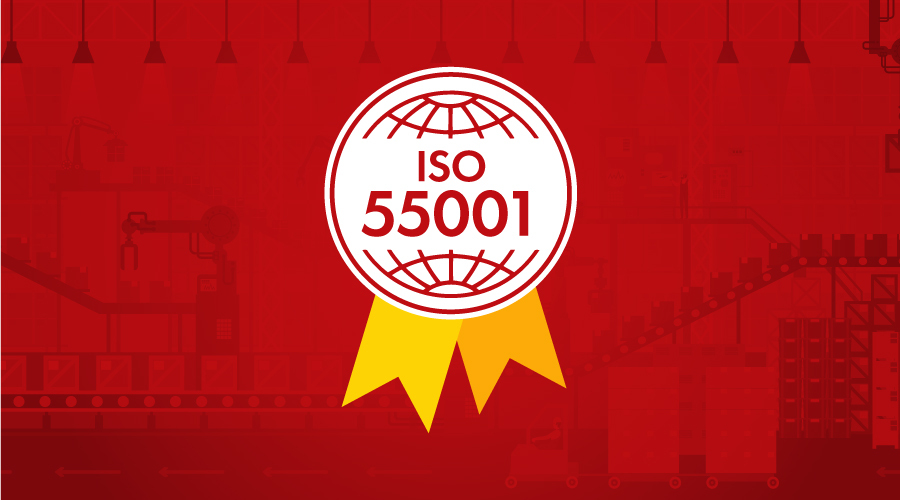
What is ISO 55001? What are its Key Implementation Steps and Benefits?
26th May, 2021
Assets whether small or big are an integral part of any organization. In simple words, assets can be tangible or intangible and include everything from IT components, property, inventory, and intellectual property, owned or leased by a company to operate. The assets have a great potential to add value to any business.
.
ISO 55001 – Asset Management System (AMS)
It is important to manage assets effectively and ISO 55001 is capable of that. ISO 55001 is the international standard that helps organizations effectively manage their assets to optimize their lifetime value. ISO 55001 standard is especially crucial in industries that are capital intensive and have numerous assets.
ISO 55001 provides a competent asset management framework to establish, implement, maintain, and improve effective control and governance of assets to realize value through managing risk and opportunity, in order to achieve the desired balance of cost, risk, and performance. Some of the significant improvements witnessed by organizations are:
- 15 % reduction in Operational Costs
- 10 % increase in Utilization / Return on capital employed
An Effective management system also focuses on creating a culture of steady improvement and can also help to:
- Improvement in Asset performance (e.g. uptime, efficiency);
- Reduction in the unit cost of product or service;
- Improved reliability & availability (mean time/distance between failures);
- Improves life cycle costs
.
Understanding Terms and Definitions Related to ISO 55001
Before we dive deeper into the details, let us look at the meanings of some terms and definitions for better understanding.
Asset: “Item, thing, or entity that has potential or actual value to an organization.” (Reference ISO 55000:2014)
Value can be tangible or intangible, financial or non-financial,
Physical assets usually refer to equipment, inventory, and properties owned by the organization. Intangible assets refer to non-physical assets such as leases, brands, digital assets, use rights, licenses, intellectual property rights, reputation, or agreements.
Asset management: “Asset management is the coordinated activity of an organization to realize value from assets.” (Reference ISO 55001:2014)
Asset Management Ensures
Assets exist to provide value to the organization. Asset management does not focus on the asset itself, but on the value that the asset can provide to the organization.
- That organizational objective is translated into technical and financial objectives.
- Leadership and workplace culture are determinants of the realization of value.
- That asset will fulfill its required purpose.
.
Scope and Application of ISO 55001
ISO 55001 can be applied to all types of assets as well as by all types and sizes of organizations that are looking to improve the realization of value from their assets which includes the following:
- Physical assets
- Information assets
- Intangible assets
- Critical assets
- Information and Communications Technology (ICT) assets
- Infrastructure assets
- Moveable assets
Kindly note:
- Physical assets usually refer to equipment, inventory, and properties owned by the organization.
- Intangible assets refer to non-physical assets such as leases, brands, digital assets, use rights, licenses, intellectual property rights, reputation, or agreements.
.
Documentation Requirement for ISO 55001 – Asset Management System
Every organization should document the following information in order to comply with ISO 55001
a) Strategy and Planning
Corporate service levels, policy, and objectives
Strategic Asset Management Plans (SAMP) / Asset Management Strategies
Asset Management Plans
b) Process
Asset-related processes and procedures
Process performance objectives and indicators
c) Technical and Asset-related Properties
Asset attributes, ownership, design parameters, vendor information and location.
d) Service Delivery and Operations
Service levels, performance objectives, asset performance characteristics, future operational requirements and demand management objectives.
e) Maintenance Management
Historical asset failures, betterment or replacement dates and future maintenance requirements.
f) Performance Management and Reporting
Asset performance data, continuous improvement objectives and regulatory reporting.
g) Financial and Resource Management
Historical cost, depreciation, asset replacement value, date of acquisition, materiality, capitalization rules, asset classification/hierarchies, life cycle costing, analysis, useful lives of assets, residual value, and any residual liabilities.
h) Risk Management
i) Contingency and Continuity Planning
j) Contract Management
Asset-related contractual information, vendor information, services, objectives, third party agreements.
.
Key Steps to Implement ISO 55001
The International Standard can create an efficient Asset Management System that helps achieve your organization’s goal, expand or replace existing infrastructure, and comply with regulatory requirements along with other benefits if implemented properly.
An Asset Management System is a set of interrelated and interacting elements of an organization, whose function is to establish the asset management policy and asset management objectives, plans, and the processes, needed to achieve those objectives. Here the steps that need to be followed:
Step 1: Strategic Alignment to Organizational Objectives / Business objectives
The organizational objectives are generally produced from the organization’s strategic level planning activities and are documented in an organizational plan/ corporate plan.
Step 2: Asset Management Policy
- The principles by which the organization intends to apply asset management to achieve its organizational objectives should be set out in an asset management policy.
- Aligning the asset management objectives with the organizational objectives, as well as linking asset reports to financial reports, can improve the organization’s effectiveness and efficiency,
Step 3: Strategic Asset Management Plan (SAMP)
“Documented information that specifies how organizational objectives are to be converted into asset management objectives, the approach for developing asset management plans, and the role of the asset management system in supporting the achievement of the asset management objectives.” (Reference ISO 55001:2014)
A strategic asset management plan is derived from the organizational plan.
Step 4: Asset Management Objectives
- The asset should align with the product or service needs of the Organization.
- The asset management objectives transform the required outcomes ( by product or service) to be provided by the assets, into activities typically described in the asset management plan(s).
For example :
- Asset performance (e.g. uptime, efficiency)
- The unit cost of product or service
- Reliability (mean time/distance between failures)
- Asset condition, performance, or health score
- Life cycle costs
- Life expectancy
- Asset energy performance
- The total cost of ownership
- Return on capital employed
Step 5: Asset Management Plans
“Documented information that specifies the activities, resources, and timescales required for an individual asset, or a grouping of assets, to achieve the organization’s asset management objectives.” (Reference: ISO 55001:2014)
Step 6: Implementation of Asset Management Plans
Implementation of asset management systems which includes asset management policy, procedures & plans to achieve objectives.
Step 7: Asset Performance Evaluations
The organization shall evaluate and report on the asset performance and the following should be taken into account:
- The asset management performance, including financial and non-financial performance.
- The asset performance metrics and associated indicators, e.g. condition or capacity indicators.
Step 8: Asset Performance Improvement Plans
The organization should establish, implement and maintain processes for determining opportunities and assessing, prioritizing, and implementing actions to achieve continual improvement and reviewing their subsequent effectiveness.
.
Benefits of ISO 55001-Asset Management System
This international standard is a holistic business improvement framework that will be beneficial in the long run. This flexible system has many benefits, they can include but not be limited to the following:
a) Improved Financial Performance
Improving the return on investments and reducing costs.
b) Informed Asset Investment Decisions
Helps to improve investment decision-making and effectively balance costs, and performance.
c) Managed Risk
Reducing financial losses, improving health and safety, goodwill and reputation.
d) Improved Services and Outputs
Assuring the performance of assets can lead to improved services or products
e) Demonstrated Social Responsibility
Improving the organization’s ability to reduce emissions, conserve resources, and adapt to climate change.
f) Demonstrated Compliance
Transparently conforming with legal, statutory and regulatory requirements.
g) Enhanced Reputation
Improved customer satisfaction, stakeholder awareness, and confidence.
h) Improved Organizational Sustainability
Improve the sustainability of operations and the organization.
i) Improved Efficiency and Effectiveness
Improving processes, procedures, and asset performance can improve efficiency and effectiveness.
.
The 4C Roadmap to Excellence
With unmatched expertise in the industry and an analytical approach, we drive to yield the best solutions for your organization with a promise of long-term profit.
- System Value Management
Periodic monitoring, review, training and up-gradation of Management system to sustain & improve effectiveness, Planned internal audit to measure effectiveness & assistance in surveillance audit. - Registration Audit
Coordination with certification agency for audits and up-gradation of systems till certification. - Management Review
Assist Top Management to review the effectiveness of the implemented system, internal audit results, Management System Policy, Objectives and Targets. - Internal Auditor Training
Train and Lead Cross Functional Internal Audit Team to effectively audit implemented system. - Implementation and Monitoring
Function specific guidance and periodic monitoring to implement the Documented System. - Documentation
We prepare the Management System Documentation as per the requirements of ISO and Management System Standards after taking due consideration of the Gap Analysis results. - Awareness Training
Awareness Training modules are custom designed for APEX Committee and Core Team which covers the standard overview, the roadmap for certification and observations and examples gathered from the gap analysis - Gap Analysis
We identify the organization’s strength and current status; understand the gap in line with the required standard for respective departments, processes and personnel, and accordingly, formulate the Growth plan.
Our skilled consultant team at 4C can help you with all the necessary steps to grow your business and guide you through the implementation process. To know more about how you can strengthen your organization with ISO 55001-Asset Management System, reach out to our consultants now.
